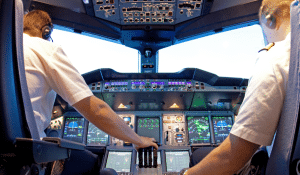Latest News

Inmarsat is looking to enter the Chinese in-flight connectivity market through cockpit upgrades that enable compliance with regional flight tracking mandates. Photo: Inmarsat
[Via Satellite 06-02-2016] Inmarsat Aviation’s Vice President of Strategy Frederik van Essen sees the Asia-Pacific region as a huge growth point for the satellite-based In-Flight Connectivity (IFC) market. Aviation mandates for flight tracking are pushing satellite-enabled IFC safety and cockpit services forward in China, making flight tracking capabilities a necessity for aircraft operating in China’s airspace. But while a recent Euroconsult study found that 22 airlines in the Asia Pacific are looking to install connectivity systems in the near future to enable passenger Wi-Fi, regulation and Internet censorship are slowing commercial penetration for connectivity
“Language is a barrier in itself. Culture is different; regulation is different,” van Essen told Via Satellite. “In general, China is a market that is not an easy market for Western companies to enter, which is why we have always worked with local partners.”
According to a recent market survey conducted by Inmarsat, nearly 92 percent of surveyed passengers worldwide would prefer to have connectivity on a flight, and more than half prefer it to In-Flight Entertainment (IFE) or in-flight meals; only 3 percent of the aircraft operating today in the Asia-Pacific offer Wi-Fi. Van Essen believes that with such a low rate of IFC equipage and a high rate of interest from passengers, connectivity can be a way for commercial operators to differentiate themselves in the growing commercial air transport industry.
“Certainly when it comes to network planning we are looking at China. China is clearly on the radar; it is one of the fastest growing aviation markets,” van Essen said.
Inmarsat, alongside Honeywell, equipped China’s first passenger Wi-Fi system on an Air China Airbus A330 in 2014. To further penetrate the region, the satellite operator recently signed a Head of Terms (HoT) agreement with China’s Beijing Marine Communication and Navigation Company (MCN) to establish a joint venture for aircraft cabin and cockpit connectivity solutions in China.
“A lot of what we are trying to do with this joint venture is to pool the specific knowledge on aviation in the global market that we have acquired with [MCN’s] local knowledge so we can speed up introducing new developments and new innovations in IFC into the Chinese market.”
Through the joint venture, for which the final agreement is expected later this year, Inmarsat would provide services, including its Ka-band broadband network service Global Xpress (GX) Aviation and SwiftBroadband-Safety (SB-S). SB-S is a flight deck communication platform that combines L-band satellite connectivity with advanced avionics to provide cockpit communications such as Automatic Dependent Surveillance-Broadcast (ADS-B) and Electronic Flight Bag (EFB) updates. The platform supports flight-tracking services that can satisfy the International Civil Aviation Organization (ICAO) mandate for sub-15 minute tracking of all aircraft as well as the Civil Aviation Authority of China (CAAC)’s more ambitious national mandate.
“In China there are specific regulations driving products in the local market. E.g. around safety, there is a four-minute voice mandate for all the Chinese airlines where they are required to equip with technology that will allow them to be in contact with their aircraft within four minutes, independent of what the local circumstances are. Those are really specific regulations that are driving airlines in China to look for specific solutions, and being close allows you to create products, such as our SwiftBroadband-Safety product, that actually meet those needs,” said van Essen.
Several of the airlines in the region are signaling that they would like to equip with passenger Wi-Fi in parallel with the required cockpit installations. Many, van Essen says, are looking for an all-inclusive solution, one that will allow an airline to comply with the flight-tracking mandate and upgrade cockpit communications as well as enable passenger Wi-Fi. With this, he believes airlines are getting “more serious” about exploring different business models for IFC. Air China, for instance, which has been trialing the technology for several years, has been indicating that they may want to begin trials on long-haul flights and eventually on narrow-body aircraft. Still, airlines are cautious.
“In general, what we see with airlines — and Chinese airlines are no different — is that when making major fleet decisions the process is very, very thorough. Air China wants to be at the forefront of in-flight connectivity but is taking a thorough approach with their trial by equipping a few aircraft and seeing how well the capabilities actually perform. I think that is a great approach because there are, in this industry, a lot of claims going around and I think the best way to see what you will actually get is to trial it for your own needs,” said van Essen.
No Chinese airlines have signed on for full scale implementation as of yet, but as companies such as Inmarsat and regional IFC companies, such as Aircom, begin to enter the region and navigate the regulatory landscape van Essen believes companies will soon learn to navigate the regulatory landscape in the Asia-Pacific, as with the U.S. and Europe.
“This is in general a very high-barrier industry; launching satellites and Complementary Ground Component (CGC) networks is very capital intensive, you need a lot of regulatory approvals … and that applies to the U.S., it applies to Europe and it applies to China,” he said.
Get the latest Via Satellite news!
Subscribe Now